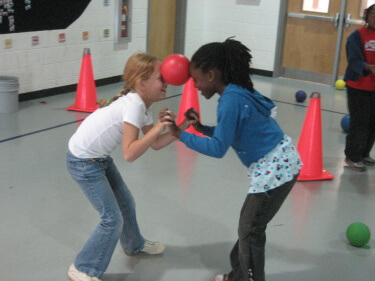(This essay was originally published on SHAPE America’s member Exchange [December, 2015] and is reprinted with permission.)
Does this scene sound familiar? You’re in a social setting and someone politely asks, “What do you do?”
Quickly the question morphs into a conversation killer if you answer, “I teach physical education.” A few seconds of uncomfortable silence follow. “What do you coach?” they ask, hoping for respite. “I don’t coach,” you say. Discomfort heightens. Blank stares. What to do?

Beyond excusing myself, I’ve learned the simplest escape is to change topics. Reversing the question works well. “What do you do?” I ask with a smile and notice a plausible sigh of relief. Most people like to be asked this question. Rarely do they have any difficulty answering.
Funny isn’t it that so many of us struggle to answer the “What do you do?” question. Perhaps it’s heightened sensitivity to the all-too-common negative “gym teacher” or “coach” stereotype?
It’s almost as if we’re embarrassed to admit publicly that we teach health and physical education. But in all honesty I don’t think that’s true. Most health educators and physical educators love what they do and believe what they do is truly valuable. So why then do we almost instinctively tell people who we are — our job title — when asked what we do?
The fact that so many of us struggle with this question is indicative of a dilemma that urgently needs resolving. We have to get clear in our own minds what we in this profession do. Because if we aren’t sure, and if we can’t clearly and eloquently express to others what we do, we shouldn’t be surprised that the public doesn’t understand or support us. And it’s this confusion that explains the common perception that health educators and physical educators don’t get the respect we deserve.
Our profession was born out of a simple and single shared belief that good physical health is essential. It is worth preserving and developing. Without good health, not much in life is important. Being smart, being funny, being talented, and being wealthy doesn’t matter much — or for long — if you’re unhealthy.
Initially, striving to get people healthy was good enough. That idea was supported, and teaching health and physical education was valued. But then things slowly changed. It wasn’t enough for the profession to focus just on being healthy.
During wartime, we were called upon to boost military conditioning. When American children were shown to be less fit than their European counterparts we were charged to fix it. And more recently, as part of the public school academic curriculum, we’ve been expected to improve reading, writing and math scores, decrease bullying, help students develop desirable social skills, inspire creativity, add assessments, follow standards, and so on. Our bucket list of performance expectations has exploded.
Attempting to be masters of all has not served the profession well. It has divided and weakened us, and diverted our attention from our core value — getting people physically healthy.
Despite so much focus within the profession today on teaching better, no one outside of the profession is complaining about our teaching. For years we’ve done our best to improve physical education teaching. And a lot has got better. But simultaneously our programs and teaching positions have continued to be cut. Not everywhere. Not everyone. But pretty much nationwide it has been and continues to be an uphill slog. Being good teachers has not secured our future.
In response, we’ve done our best to advocate. And our skills in this area have improved immensely. The inclusion of health education and physical education in the recently passed Every Student Succeeds Act (ESSA) is proof. But expecting this to change respect for our profession is wildly optimistic. You can’t force respect on people. It has to be earned. And to – earn respect you have to be valued.
If health and physical education teachers want to be valued, we must return to our core function and do it well. Coincidentally, this is precisely what the public is calling upon someone to do. Never before has there been so much concern about kids’ inactivity and poor health. It is our moment to seize because no one is better suited than us to teach healthy habits and get kids more active. But this is no easy task, and as a profession we need to focus.
It was this thinking that stirred SHAPE America’s Board of Directors to make the commitment to get all school children physically active and healthy in the next 14 years through “50 Million Strong by 2029.”
And it’s this same message that we might want to have in mind the next time someone asks us, “What do you do?”
It’s hard to imagine anyone not understanding and enthusiastically approving the answer, “I help empower all children to lead healthy and physically active lives through effective health and physical education programs.”
